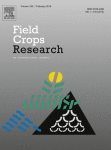Ver ítem
- xmlui.general.dspace_homeCentros Regionales y EEAsCentro Regional Buenos Aires NorteEEA PergaminoArtículos científicosxmlui.ArtifactBrowser.ItemViewer.trail
- Inicio
- Centros Regionales y EEAs
- Centro Regional Buenos Aires Norte
- EEA Pergamino
- Artículos científicos
- Ver ítem
Kernel number and kernel weight determination in dent and popcorn maize
Resumen
Yield formation in maize (Zea mays L.) dent hybrids has been directly linked to the rate of plant biomass accumulation and partitioning of assimilates to the developing grain. Maize popcorn genotypes have been studied less extensively, but their kernels are known to differ in terms of endosperm structure and typical growth patterns. Our objective was to evaluate how variation in plant growth rate (PGR) at different stages of kernel formation and
[ver mas...]
Yield formation in maize (Zea mays L.) dent hybrids has been directly linked to the rate of plant biomass accumulation and partitioning of assimilates to the developing grain. Maize popcorn genotypes have been studied less extensively, but their kernels are known to differ in terms of endosperm structure and typical growth patterns. Our objective was to evaluate how variation in plant growth rate (PGR) at different stages of kernel formation and development affected kernel number per plant (KNP), individual kernel weight (KW) and rate and duration of kernel growth in popcorn genotypes, relative to dent ones. We conducted three experiments (two in Ames, Iowa, and one in Pergamino, Argentina) in which PGRs around flowering and during the linear phase of the grain-filling period of four dent and eight popcorn genotypes were altered by plant density, defoliations and thinning treatments. Yield per plant, KNP, KW, rate and duration of kernel growth all showed significant kernel type (popcorns vs. dents) effects (p < 0.01). KNP was highly correlated with ear biomass accumulated around flowering in dents and popcorns, and popcorns showed a higher efficiency for setting kernels per unit of ear biomass accumulated around flowering (p < 0.01). Popcorn inbred R18 in particular showed a significantly higher efficiency, consistent across experiments. Relationships between potential KW at early grain filling or kernel growth rate and the PGR per kernel around flowering were different for dent and popcorn genotypes. Most popcorns established a lower potential KW compared to dent genotypes at similar PGRs per kernel around flowering. Also, popcorn kernels were less prone to decrease KW in response to severe reductions in plant growth during the linear phase of the grain-filling period as promoted by defoliation treatments (significant kernel type × source manipulation treatment interaction, p < 0.001). Despite different patterns of KNP and KW determination, yield variation across dent and popcorn genotypes and environments corresponded closely to the potential sink capacity established by the end of the lag phase 14 days after anthesis. This result emphasizes the importance of the flowering period to establish KN and KW across different maize germplasm.
[Cerrar]

Autor
Severini, Alan David;
Borrás, Lucas;
Westgate, Mark E.;
Cirilo, Alfredo Gabriel;
Fuente
Field Crops Research 120 (3) : 360-369 (February 2011)
Fecha
2011-02
Editorial
Elsevier
ISSN
0378-4290
1872-6852
1872-6852
Formato
pdf
Tipo de documento
artículo
Palabras Claves
Derechos de acceso
Restringido
 Excepto donde se diga explicitamente, este item se publica bajo la siguiente descripción: Creative Commons Attribution-NonCommercial-ShareAlike 2.5 Unported (CC BY-NC-SA 2.5)
Excepto donde se diga explicitamente, este item se publica bajo la siguiente descripción: Creative Commons Attribution-NonCommercial-ShareAlike 2.5 Unported (CC BY-NC-SA 2.5)

